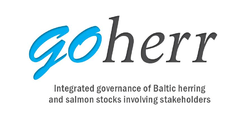Goherr: WP3 Scenarios and management objectives
Jump to navigation
Jump to search
| [show] This page is a encyclopedia article.
The page identifier is Op_en7152 |
|---|
Summary of workpackage
| Work package number: | WP 3 | |||||
| Start date or starting event: | Month 1 | |||||
| Work package title: | Scenarios and management objectives | |||||
| Activity Type: | RTD | |||||
| Participant number | 5 | 1 | 2 | 3 | 4 | |
| Participant short name | UOULU | UH | THL | IFM-AAU | SLU | |
| Person-months per participant | 15 | 16 | 2 | 0 | 0 | |
Contact information
| Name | Institution | skype | phone | Responsibilities | |
|---|---|---|---|---|---|
| Timo P. Karjalainen | Thule institute, University of Oulu | timo.p.karjalainen@oulu.fi | PI; WP3 leader | ||
| Simo Sarkki | Thule institute, University of Oulu | simo.sarkki@oulu.fi | |||
| Mia Pihlajamäki | Thule institute, University of Oulu | mia.pihlajamaki@oulu.fi |
DoW
Objectives
- 1. Define objectives for integrated salmon and herring policy
- 2. Define pathways for reaching the objectives
- 3. Build exploratory future scenarios for eutrophication and dioxin input in the Baltic Sea, and for the use of Baltic herring and salmon
Tasks
- Task 3.1. Defining desired future state and objectives for integrated salmon and herring policy (UOULU, UH, THL) (Month 12)
- Representatives from different stakeholder groups (fishers, consumers, eNGOs, authorities, scientists) will be involved in defining and prioritizing biological, social, economic, and human health related objectives for integrated salmon and herring policy. First, a questionnaire study using internet based survey tool Webropol(www.webropol.fi) will be carried out targeted to stakeholder groups. The results of the questionnaire will be evaluated with stakeholders in the International Workshop No1 (month 10), and based on that, objectives and targets will be defined both in qualitative and quantitative terms (e.g. target % to decrease dioxin level in fish), in collaboration with WP2 (Task2.2). The method of value-focused thinking will be used. It is a systematic procedure for identifying and structuring values and objectives by dividing the objectives into a)fundamental - b) means - c) process-, and d) organizational objectives (Keeney, 1992). The method is expected to lead to thoughtful and innovative management options (Arvai et al., 2001; Gregory and Keeney,1994).
- Task 3.2. Identifying desirable future paths to reach the objectives (UOULU, UH, THL) (Month 20)
- In the International Workshop No1 (month 10), defining the management objectives and targets for salmon and herring will be followed by identifying pathways to reach the desired management outcomes (e.g. what changes are needed, who should change and what, when). The proposed changes will be analysed backwards from the objective to the current situation, and a timeline for changes required to meet the future targets will be created. We apply the backcasting methodology (e.g. Robinson 2003), by not only focusing on desired outcomes, but also elaborating the processes needed to achieve the outcomes.
- Task.3.3. Building scenarios (UOULU, UH) (Month 28)
- An exploratory approach will be used in scenario building, based on existing large scale environmental scenarios (e.g. the Global Environmental Outlook), literature reviews (WP2), stakeholder interviews (WP2), the work on dioxin (WP5), and expert workshops (scientists, authorities, industry representatives). The aim is to: a) Build and explore four integrative scenarios for the future of Baltic salmon and herring regarding threats, state, impacts and governance responses, and; b) Build scenarios up to year 2040 for the needs of the Decision Support Tool (WP6) related to 1) eutrophication and 2) dioxin releases, 3) the use of Baltic herring, and 4) salmon policy, by taking into account different political, economic, social, technical, climate change-related etc. circumstances. For the Decision Support Tool (WP6) the probability of materialization of each identified scenario will be estimated by probabilities. Experts’ views will also be interviewed in relation to potential management measures to decrease eutrophication and dioxin input in the Baltic.
Tentative timeline
Deliverables
- Deliverables (brief description and month of delivery)
- D3.1 Report/MS: Concretizing fundamental values to normative future targets: What are the objectives and outcomes of Baltic salmon and herring governance processes (Month 14). Responsible partner: UOULU.
- D3.2. Online description of the scenarios developed, applicable in the dioxin model (Task 5.1) and decision support model of WP6 (Month 16) Responsible partner: UOULU
- D3.3. Report/MS: Exploring futures of Baltic salmon and herring by assessing potential impacts of ecosystem approach (Month 20). Responsible partner: UOULU.
- D3.4 Report/MS: From context specifics to robust recommendations: targeted future proposals to make
Baltic salmon and herring governance more sustainable (Month 24). Responsible partner: UOULU.
- D3.5. Journal publication (submitted): Developing the scenario methodology in the context of complex multilevel fisheries governance (Month 26). Responsible partner: UOULU.


